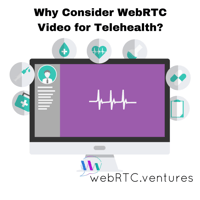According to a recent article published by Kaiser Health News, Medicare is penalizing over 2500...
Viewpoint on WebRTC for mHealth
Is WebRTC the best way to deliver telehealth consultations? What are the pros and cons?
I tried to address those questions to mobile health professionals in a recent edition of the mHealth Journal. In my viewpoint column entitled “WebRTC: delivering telehealth in the browser”, I give an overview of WebRTC, and the unique challenges and benefits it offers for telemedicine applications.
I have included a summary of the key points below, and you can also read the full article on mHealth.
Pros of WebRTC for Telehealth
- Peer to Peer – No intermediate server means more patient privacy and more secure applications.
- Encrypted – good for HIPAA compliance! All video, audio, and data is encrypted in transit.
- No plugins – This means no special installs for healthcare professionals or patients.
Cons of WebRTC for Telehealth
- Peer to Peer – Works great for small conversations but doesn’t scale well to large conversations. Larger conversations are often implemented by moving to a less pure WebRTC implementation that involves intermediate media servers.
- Browser support – Only in Chrome/Firefox/Opera, no Internet Explorer or Safari yet!
- Mobile support – No native support on iOS, additional work is necessary using other libraries to build a native app with WebRTC support.
WebRTC doesn’t make telehealth easy, but it does make it possible in a way not possible in the browser previously. Interested in building a telehealth app based on WebRTC? Contact us and I’d be happy to discuss it with you!
CPaaS,
Managed Services,
Events,
Video Conferencing,
Real Time Weekly,
WebRTC Architecture,
Broadcasting,
Medical,
WebRTC Live,
Showcase,
Thoughts,
Vonage,
Daily,
Jobs,
Contact Centers,
Telehealth,
Education,
Technical,
General,
Story of success,
The WebRTC.ventures Blog,
Testing,
Gaming,
DevOps,
Symbl.ai



